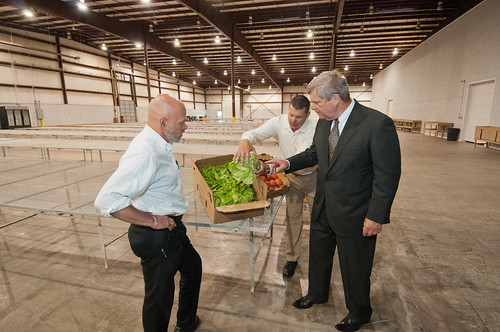
Mark Seale got out of agriculture early. A Virginia native raised on the family farm, he didn’t see a future in the business once he finished high school – and his family didn’t argue with him.
But over the years, Mark found himself drawn back to agriculture in Virginia. Working with produce was something he’d grown up around, and a desire to do something in the industry was tugging at him. He returned to Virginia and opened Simply Fresh Produce, a retail outlet in Charlottesville. That’s where he met Jim Epstein, a real estate developer concerned about the disappearance of Virginia farmland. Jim knew that economically viable farms were the best buffer against development pressure and that smart development could in turn strengthen the local food system. So in 2010, Jim and Mark joined forces to build Blue Ridge Produce, a food hub in the rural community of Elkwood.
On Thursday, I had the pleasure of visiting Blue Ridge Produce with USDA Secretary Tom Vilsack. Our tour took us through the large warehouse, loading docks, coolers – mostly empty, as Blue Ridge turns over its entire inventory every 12 hours – and greenhouse space. Now working with 130 growers, Blue Ridge aggregates their products and markets them to buyers such as Whole Foods and Harris Teeter grocery stores, a DC-based hospital system, and Chipotle restaurants on the mid-Atlantic seaboard.
Food hubs, including Blue Ridge Produce, don’t just aggregate and market local food. They work with growers on production planning, helping ensure a steady supply of diverse products throughout the year. Blue Ridge trains growers on quality assurance practices, including GAP certification.
At USDA, we often talk about the potential of food hubs like Blue Ridge Produce to help farmers scale up from selling at a farm stand or farmers market to reaching institutions and wholesalers. Thursday’s tour was evidence that this is happening. In 2012, 20 percent of the growers supplying Blue Ridge increased their acreage under production in response to growing demand. Mark told the story of one farmer who started selling to Blue Ridge off of a 3-acre plot of tomatoes. Today, he’s farming 45 acres. That’s the kind of opportunity that food hubs create.
On Thursday, the Secretary and I were joined by leadership from the Virginia state offices of USDA Rural Development, the Farm Service Agency and the Natural Resources Conservation Service. Although Blue Ridge hasn’t applied for USDA support in the past, they’re eager to hear about the opportunities – and to share that information with their growers.
We talked about USDA’s Seasonal High Tunnel initiative, which could help growers conserve resources and extend their growing season to supply Blue Ridge with produce year round. USDA’s micro-loan program is perfect for smaller producers who may only need $35,000 or less to purchase a piece of equipment or make a downpayment that will help them expand in the future. Blue Ridge is interested in connecting growers to school districts in the region, and USDA’s Farm to School Grant Program could help with the planning process. The Rural Energy for America Program could assist with alternative generation at the food hub itself.
Blue Ridge has also experienced a shortage of organic product, with demand far outstripping supply. USDA’s National Organic Program – including resources developed as part of USDA’s Organic Literacy Initiative – will give growers the information they need to decide whether to transition to organic and meet the market demand.
Blue Ridge Produce is one of more than 220 food hubs around the country creating new opportunities for farmers and ranchers. USDA supports these efforts with funding, research, and technical assistance. To learn more, check out our food hub portal website; read about infrastructure in the Know Your Farmer, Know Your Food Compass, or search our Compass map for food hubs.
